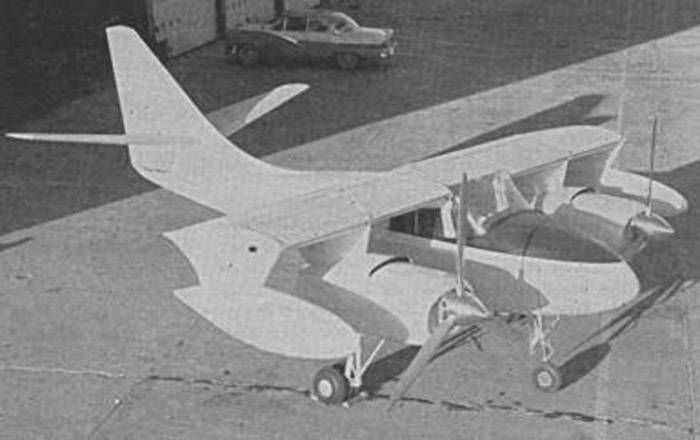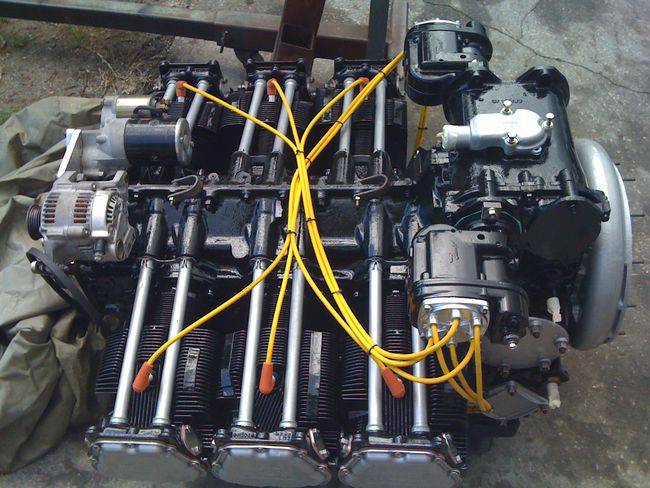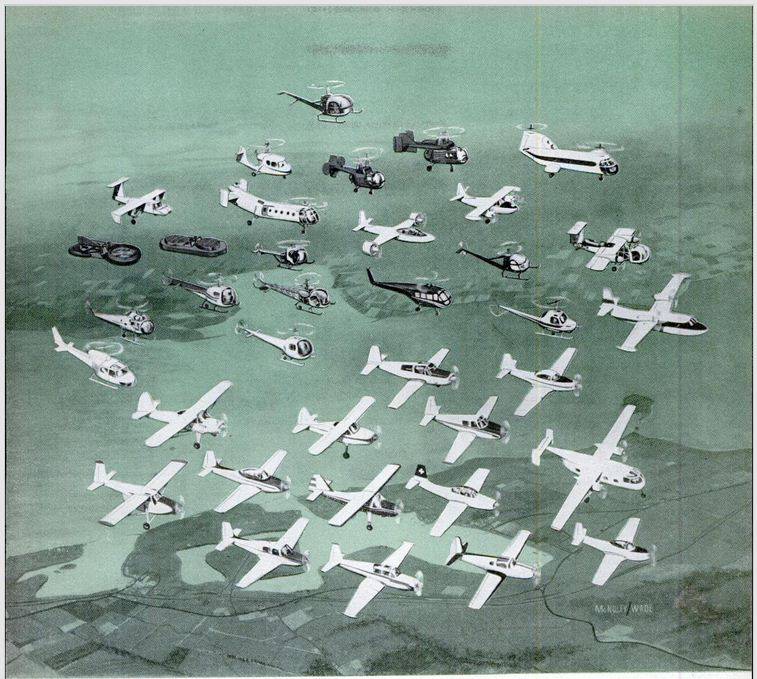Experimental aircraft Robertson VTOL (USA)
The Robertson VTOL project started in the fall of 1956. Robertson Aircraft Corporation began to develop a new machine with unusual capabilities. It is noteworthy that this organization was founded in October 56th specifically for work on a new project of a vertical or shortened take-off aircraft. It should be noted that the Robertson company, which worked on the VTOL project, has nothing to do with the company of the same name, which was building aviation equipment in the interwar period. The "old" Robertson Aircraft Corporation by that time managed to cease its activities.
In just a few months, the company-developer, not loaded with other orders, completed the design, and then built a prototype of the aircraft. Due to this, at the beginning of 1957, it was planned to conduct the first tests of the prototype aircraft. All these plans were successfully implemented, but further work was hampered by the results of inspections of new equipment.

The only surviving snapshot of a Robertson VTOL aircraft. Photo Vertipedia.vtol.org
In the fifties, several techniques were proposed to improve the take-off and landing characteristics of aircraft, which made it possible to drastically reduce the take-off run or ensure vertical take-off. All these methods differed in terms of technology and implementation complexity. The designers of Robertson selected one of the easiest ways to improve performance - air deflection technology. In addition, the new project VTOL proposed to use some other ideas that would simplify the design of the aircraft in comparison with other similar samples of the time.
The project of the company Robertson Aircraft Corporation received the simplest working title, which fully reflected its goals. The car was called VTOL (Vertical Take-off and Landing - “Vertical take-off and landing”). As far as we know, the US military showed no interest in this development, which is why it did not receive an army designation with the letters “VZ”. In addition, the project simply did not reach those stages at which it could be used in the army.
It was suggested to practice new ideas with the help of a relatively simple aircraft. Experimental Robertson VTOL was supposed to be a twin-engine high-wing with a wing of the original design. It was proposed to use the fuselage, powerplant, chassis and plumage of traditional schemes. An interesting feature of the project, which distinguished it from its modern counterparts, was to be the presence of a full-fledged closed cockpit for the pilot and several passengers or another payload.
For the aircraft of the new type, a fuselage was developed, similar to that used in other light-duty car projects. There was a nose cone of ogival shape, smoothly mated with divergent sides. Behind the fairing there was an inclined cockpit windshield, above which were mounted the means of fastening the wing. Behind the passenger cabin, which was distinguished by a relatively long length, the fuselage began to taper. In the narrow tail section, the keel and a stabilizer with a large transverse V were located on it. Some features of the fuselage suggest that Robertson Aircraft Corporation manufactured its aircraft by modifying the existing serial machine of another company, but there are no exact data on this.
Much of the internal volume of the fuselage was given for the placement of the cabin. Inside the available volume, the project authors placed four seats for the pilot and passengers. Access to the cabin was carried out using side doors. There was a large frontal and side glazing. An interesting feature of the layout of the machine was the lack of fuselage tanks for fuel and oil. Capacities for the necessary liquids were placed in the wing and its aggregates. In this case, probably, inside the fuselage there should have been some devices that control the wing assemblies.
The experimental Robertson VTOL aircraft received a high-lying straight wing with well-developed mechanization. To the top of the fuselage was proposed to mount a rectangular in plan the main wing of the unit, which had a relatively thick profile. In the middle of each plane was placed a pylon with a relatively large engine nacelle. In other experimental projects of a similar kind, the only engine was in the fuselage and was connected to propellers with the help of a complex transmission. The project of the company "Robertson" meant the use of two full-fledged propeller groups. The engines were located inside their own streamlined gondolas.
To prevent the flow of air flow, large wing tips were used. The basis of such a device was a trapezoidal plate. Large drop-shaped tanks placed on the bottom of the tips have become an additional means of controlling the flow.

Piston engine Lycoming GSO-480, top view. Photo of Ranger08 / Southernairboat.com
It was proposed to install the Lycoming GSO-480 gasoline engines in two underwing gondolas. The six-cylinder horizontal boxer engine was equipped with a supercharger and developed power up to the 340 hp. The engine had a built-in gearbox, necessary for lowering the speed when using a propeller. The cylinder block was cooled by air entering through the windows in the nose fairing of the nacelle. The Robertson VTOL aircraft had to be completed with two three-bladed propellers of relatively large diameter. In order to improve the wing's blowing and, as a result, to improve its characteristics, the propeller drive should have almost completely overlapped the wing.
The main way to improve the take-off and landing characteristics under the new project was to be advanced wing mechanization. On the back of the stationary plane retractable two-slot flaps of a large area, which occupied the whole span of the wing, were located. When outputting at small angles, such flaps could be used in “traditional” quality. A larger deviation of these planes led to an additional increase in lift. At maximum output, the wing, flaps, tips and sides of the fuselage formed a box-like structure that guided the air flow from the screw down and back, which could be used to improve takeoff and landing characteristics or even to get new opportunities.
Exact information about the control systems of the aircraft is not preserved. It is known that he had the classic rudders of height and direction, placed on the tail. At the same time, the presence of large flaps located throughout the wing span did not allow the aircraft to be equipped with ailerons. It is not known exactly how it was proposed to carry out roll control with the flaps released. It was possible that control of the list was proposed due to the differential change in the thrust of the engines, affecting the lifting force of the planes.
The experimental aircraft received a three-point chassis with a nose strut. In the central part of the fuselage, near the cabin, there were two main racks. To facilitate the construction, they were made non-removable, and the wheel mounts were located on a relatively simple pipe construction. Under the nose fairing there was a non-removable stand with a shock absorber and a small-diameter wheel. The tail crutch to protect the fuselage from impacts on the runway was not used.
A curious feature of the Robertson VTOL aircraft, which was completely uncharacteristic of the experimental machines of the time, was the presence of a multi-seat cabin. In the general compartment in two rows four seats for the pilot and passengers were located. The pilot's seat had a set of all necessary controls, both traditional for aircraft and new ones, the presence of which was associated with the use of some devices and units.
The development of the project Robertson VTOL was completed at the end of 1956 of the year, which allowed the construction of a prototype to begin quickly enough. The first prototype, designed for testing, was completed in December of the same year. In the near future it was planned to begin ground checks, and then raise the plane into the air. The start of this phase of the project was scheduled for early January 57.
Already on January 8, an experienced model of the new model performed the first ascent into the air using the technology of deflecting airflow using large flaps. Since information about the real capabilities of the machine was still missing, the first approach was conducted using tethered cables. For some time, an experimental aircraft was in the air, showing the real effectiveness of the powerplant and wing used. They really allowed the car to float almost vertically. After completing the entire program of the first tethered flight, the prototype sank to the ground.

Robertson VTOL in advertising Lycoming engines on the pages of the magazine Flight Magazine
As it became clear later, Robertson VTOL took off for the first and last time. More flights of the experimental machine were not conducted. The exact reasons for this remain unknown, but the available information allows us to draw some conclusions and make it possible to determine a list of possible problems that put an end to the tests.
It makes sense to compare the development of the company Robertson Aircraft Corporation with other similar projects of the time. Such a comparison shows that the Robertson VTOL aircraft, due to a number of characteristic features, was significantly heavier than its competitors, which could adversely affect its flight data. It could also have a serious drawback in the form of the lack of special control systems designed for use when flying at low speeds. There is no information about the use of gas rudders or additional tail rotors: without such systems, the aircraft could not normally be controlled during a vertical or shortened take-off, which made it extremely dangerous for itself and the crew. Another disadvantage is the placement of engines in the underwing gondolas. Large units, despite their streamlined shape, could have a negative impact on the flow of air flow, worsening the aerodynamics of the wing.
The exact list of negative features of the Robertson VTOL project, unfortunately, has not been preserved. Nevertheless, the consequences of these shortcomings are well known. An experimental 8 aircraft on January 1957 of the year made the first and only tethered flight. More tests were not carried out, because in its current form the machine did not meet the existing requirements. Due to the lack of real prospects, the original project was closed, and did not produce the expected results. The only built sample of the aircraft was later dismantled. Now it can be seen only in the only surviving photograph.
An interesting fact is that all work on the Roberton VTOL project was stopped in 1957-58 years, but the experimental plane was not immediately forgotten. Thus, in the February issue of Flying Magazine magazine for 1959 a year featured an advertisement for Lycoming engines. In confirmation of the slogan “the leading manufacturer of aircraft engines”, more than six dozen samples of aircraft equipped with Lycoming engines were drawn on the whole magazine turn. Among the serial aircraft and helicopters, as well as experimental aircraft, the Robertson VTOL machine was also present in such advertising. Even after its completion, the original project helped the further development of aviation, even if in the role of a “participant” in aircraft engine advertising.
Not getting the expected results, Robertson Aircraft Corporation was forced to stop work on the pilot project. The experience gained in the design and testing of aircraft, apparently, was never used in new projects. The creation of the Robertson VTOL aircraft was carried out on its own initiative and without the support of the military department, because of which the developments had no noticeable chances to get to other aircraft building organizations. As a result, the original and unusual project did not receive the planned continuation, and also remained without further development. The study of the problems of vertical / shortened take-off and landing further proceeded without taking into account the experience of Robertson.
Based on:
http://vertipedia.vtol.org/
http://skypioneers.kiev.ua/
http://prototypes.free.fr/
Flying Magazine. February 1959
Information